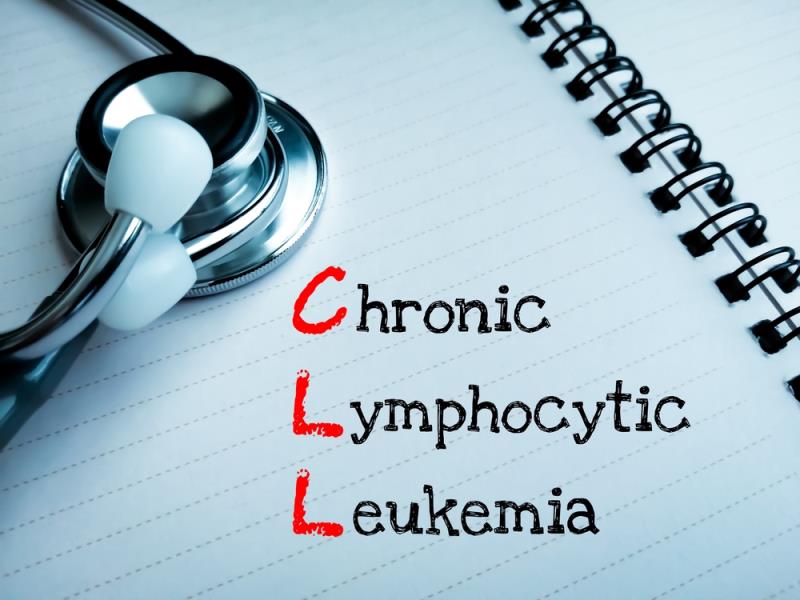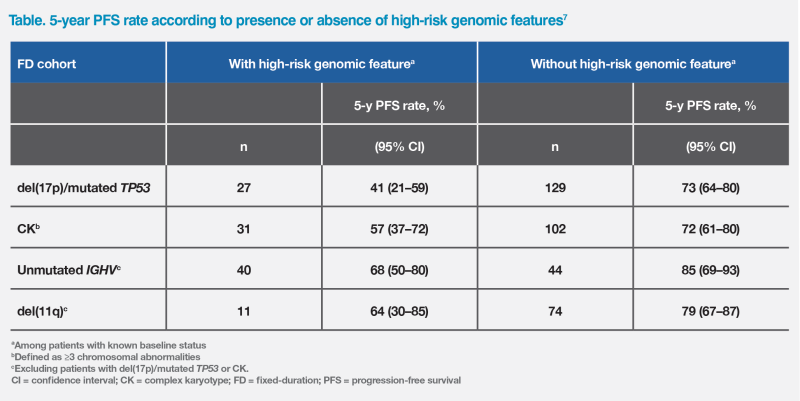First-line fixed-duration BTK inhibitor plus BCL-2 inhibitor in a patient with CLL





History and presentation
A 59-year-old female was referred to our clinic in 2017 with a confirmed diagnosis of chronic lymphocytic leukaemia (CLL). Her Eastern Cooperative Oncology Group performance status was 0. She had dyslipidaemia for which she was receiving statin therapy, but no other remarkable history.
She initially presented at a general clinic in the public sector for an upper respiratory tract illness. Blood tests showed an elevated lymphocyte count. The patient did not have anaemia, thrombocytopenia, B symptoms (ie, fever, drenching night sweats, weight loss) or clinical lymphadenopathy but being concerned, she consulted a private haematologist while awaiting her follow-up appointment at the public hospital. Blood tests performed at the private hospital, including flow cytometry, confirmed a CD5-positive lymphoproliferative disorder. Subsequent bone marrow biopsy confirmed the diagnosis of CLL and fluorescence in situ hybridization confirmed del(13q) and mutated IGHV, with no other cytogenetic abnormalities. She subsequently presented at our clinic where we have managed her since 2017.
Between 2017 and 2023, she did not develop any symptoms (eg, B symptoms, anaemia, thrombocytopenia) or signs of lymphadenopathy or hepatosplenomegaly on PET-CT scan. Follow-up blood test in September 2023 showed a marked increase in lymphocyte count, with a lymphocyte doubling time of <6 months, while cytopenia and anaemia were mild.
First-line treatment and response
In accordance with guidelines of the British Society of Haematology and those of the International Workshop on Chronic Lymphocytic Leukemia (iwCLL), which state that treatment initiation can be considered in the presence of progressive lymphocytosis with an increase of >50 percent over a 2-month period or lymphocyte doubling time of <6 months, and taking into account the patient’s concern about disease progression, we initiated treatment for CLL in November 2023.1,2
Considering the patient’s wish to avoid parenteral injection or infusion and her eligibility for full reimbursement of medication by the government, we started her on all-oral fixed-duration (FD) treatment with three cycles of single-agent ibrutinib (420 mg QD) (a Bruton tyrosine kinase [BTK] inhibitor) followed by combined ibrutinib plus venetoclax (a B-cell lymphoma-2 [BCL-2] inhibitor), with venetoclax being given according to a ramp-up schedule.3
When treatment was initiated, the patient was given febuxostat, a urate-lowering agent, as prophylaxis for tumour lysis syndrome (TLS) and acyclovir to prevent varicella zoster virus reactivation.4,5 She did not report any side effects. No resistance mutations or second malignancies were identified.
Last seen in November 2024, the patient had received 13 cycles of ibrutinib (of which 10 were administered in combination with venetoclax) and achieved complete response (CR). She has been free from disease progression for at least 12 months.
The patient continues to be followed up every 4 weeks. Follow-up involves full blood test and physical examination to check for any lymphadenopathy. As of November 2024, the patient was due to receive two more cycles of ibrutinib plus venetoclax before completing FD treatment.5
Discussion
Patients who are stable at the time of CLL diagnosis do not require immediate treatment. Indications to initiate treatment include progressive lymphocytosis (ie, lymphocyte doubling time <6 months, as noted in our patient), unintended weight loss, significant cytopenia, or hepatosplenomegaly.2
First-line treatment decisions for CLL are based on risk stratification, which takes into account the presence of adverse genetic abnormalities (eg, unmutated IGHV, complex karyotype, del[17p]) and tumour burden, as well as patient’s age and fitness.6 If feasible, patient’s preferences should also be considered.
The choice of the all-oral ibrutinib plus venetoclax regimen for our patient was based on results of the international, multicentre, randomized phase II CAPTIVATE study, our patient’s needle phobia and her desire for FD treatment. The FD cohort of the CAPTIVATE study included 159 patients aged ≤70 years with previously untreated CLL or small lymphocytic lymphoma. After a median follow-up of 61.2 months, 5-year PFS and OS rates were 67 and 96 percent, respectively.7
At a median time on study of 56 months, the CR rate (including CR with incomplete bone marrow recovery [CRi]) was 58 percent, while overall response rate was 96 percent. Median duration of CR/CRi was not reached in patients who achieved CR/CRi (n=92), of whom 98 percent achieved durable CR/CRi lasting ≥12 cycles, which is consistent with our patient’s experience.8
Of note, CAPTIVATE included a high proportion of patients with ≥1 high-risk disease features, including del(17p) (13 percent), del(17p) and/or mutated TP53 (17 percent), complex karyotype (19 percent), del(11q) without del(17p) (18 percent), or unmutated IGHV (56 percent). After a median follow-up of 61.2 months, ibrutinib plus venetoclax continued to provide clinically meaningful PFS in these patients, as well as in the overall population.7 (Table)

Importantly, ibrutinib plus venetoclax appears to be well tolerated. At baseline, 21 percent of patients in CAPTIVATE were in the high tumour burden category for TLS risk, which reduced to 1 percent following three cycles of ibrutinib lead-in. While our patient did not experience any adverse events (AEs), the most common treatment-emergent AEs in the primary analysis of CAPTIVATE (median time on study, 27.9 months) were diarrhoea (62 percent), nausea (43 percent), neutropenia (42 percent), and arthralgia (33 percent). AEs were primarily of grade 1 or 2 in severity. The most common grade 3/4 AEs were neutropenia (33 percent), hypertension (6 percent), and decreased neutrophil count (5 percent). At the time, serious AEs occurred in 23 percent of patients.3
Data on serious AEs considered related to study treatment and second malignancies continue to be collected after completion of FD treatment. In total, after a median time on study of 56 months, second malignancies occurred in 8 percent of patients since completion of treatment.8
FD ibrutinib plus venetoclax may mitigate the development of resistance mechanisms associated with continuous single-agent targeted therapies. To date (after a median time on study of 56 months), acquired resistance–associated subclonal mutation in BCL2 (A113G) occurred in only one out of 40 patients with available samples at disease progression. No other clinically relevant mutations (including BTK and PLCG2) were noted in the remaining patients.8,9
Conclusion
Ibrutinib plus venetoclax is an alloral, once-daily, FD regimen for first-line treatment of CLL that requires minimal use of public hospital resources and is convenient for patients. With up to 5.5 years of follow-up, it continues to provide clinically meaningful PFS in the overall population, as well as in patients with high-risk genomic features. Our patient’s case, with no reported AEs and a PFS of ≥12 months, illustrates this regimen’s long-term tolerability and lasting efficacy.